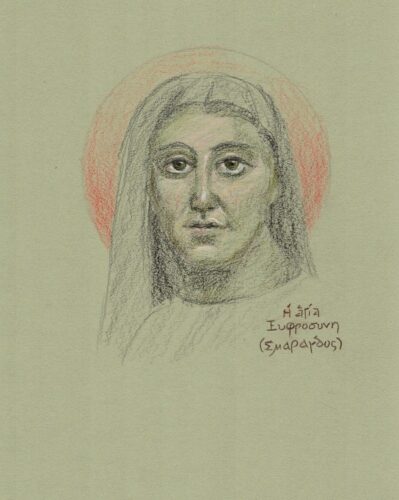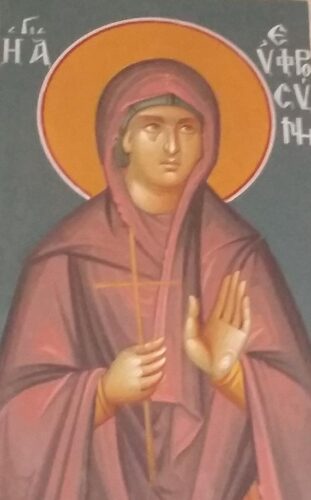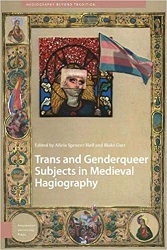Last Updated on September 21, 2024 by Kittredge Cherry

Euphrosyne / Smaragdus (Emerald) of Alexandria is a 5th-century saint who left life as a woman to become a monk in an Egyptian monastery.
Raised as the daughter of a wealthy couple, the future saint ran away from home at age 18 to avoid heterosexual marriage. Euphrosyne changed her named to Smaragdus, which means emerald, and convinced a wandering monk to provide a short haircut in the tonsured style of monks. Switching to male clothing, Smaragdus presented himself as a eunuch at a monastery that he had visited since childhood and was accepted into the monastic community. In an apparent acknowledgement of same-sex desire in monasteries, the abbot ordered young Smaragdus to live in a separate cell to avoid arousing the other monks.
After decades as a monk, this emerald of God was assigned to care for the saint’s own father, Paphnutius, who still grieved the disappearance of his only child. He did not recognize Smaragdus’ as his own long-lost child until the saint revealed the truth to him shortly before dying. They reconciled and the father also became a monk in the same monastery, living in Smaragdus’ old cell and eventually being recognized as a saint too.
A Greek Orthodox prayer to Euphrosyne says, “The image of God, was faithfully preserved in you… Your actions you taught us to look beyond the flesh…” Therefore it implicitly affirms that Christians saints do not need to live according to the sex assigned as birth.

Fresco of Saint Euphrosyne of Alexandria in a Greek Orthodox Church (Wikipedia)
A portrait of Euphrosyne / Smaragdus with large, magnetic eyes was sketched by Tobias Haller. It appears at the top of this post. This mysterious icon has exaggerated eyes based on the Fayum mummy portraits of upper-class people in Roman Egypt. Haller is an iconographer, author, composer, and retired vicar of Saint James Episcopal Church in the Bronx, still assisting at a parish in Baltimore, Maryland. Haller enjoys expanding the diversity of icons available by creating icons of LGBTQ people and other progressive holy figures as well as traditional saints.
The queer saint is a fairly new addition to the Episcopal calendar of feasts, approved in 2018. The feast day for Euphrosyne / Smaragdus is Sept. 25 in the Episcopal and Greek Orthodox traditions and Jan. 16 in the Roman Catholic church.
Euphrosyne / Smaragdus shares a similar story with more than 20 queer saints. They are venerated as women who cross-dressed as men in order to serve God and avoid marriage. Q Spirit presents an overview of them in “Trans Saints? Early cross-dressing monks and martyrs.”
There are actually two queer saints named Euphrosyne. The other is Euphrosyne the Younger / Johannes (c. 854-923), who avoided marriage to a man by putting on male clothing, adopting the name Johannes and sailing away on a ship to live as a monk and hermit. After many years this queer saint resumed a female identity, returned to Constantinople and lived as a celebrated wise woman and holy ascetic. This queer saint is commemorated on Nov. 8. This is NOT the same Saint Euphrosyne who adopted the male name Smaragdus. It’s hard to keep track of all the queer saints with their multiple unusual names!
Books explore Euphrosyne / Smaragdus
A chapter on is Euphrosyne / Smaragdus included in the widely acclaimed book “Trans and Genderqueer Subjects in Medieval Hagiography” by Alicia Spencer-Hall and Blake Gutt (editors).

Scholar Vanessa Wright explores illustrations of the saint in three 14th-century Parisian manuscripts in the chapter “Illuminating Queer Gender Identity in the Manuscripts of the ‘Vie de sainte Eufrosine.’” It compares how the saint’s gender expression was represented by medieval artists Maubeuge Master and the Fauvel Master. In Old French the saint is known as Eufrosyne / Esmarade. The book was on Q Spirit’s list of the top LGBTQ Christian books of 2021.
There is also a chapter on Euphrosyne / Smaragdus in “Between Medieval Men: Male Friendship and Desire in Early Medieval English Literature” by David Clark, from Oxford University Press.
The 2021 book “The Life of Saint Eufrosine: In Old French Verse, with English Translation” by Amy V. Ogden (translator) provides the first full translation of this epic poem into English. Only fragments of the poem have been translated before. Published by the Modern Language Association of America.
___
Top image credit
Euphrosyne / Smaragdus by Tobias Haller
___
This post is part of the LGBTQ Saints series by Kittredge Cherry. Traditional and alternative saints, people in the Bible, LGBT and queer martyrs, authors, theologians, religious leaders, artists, deities and other figures of special interest to lesbian, gay, bisexual and transgender and queer (LGBTQ) people and our allies are covered.
This article was originally published on Q Spirit on Sept. 25, 2023.
Copyright © Kittredge Cherry. All rights reserved.
Qspirit.net presents the Jesus in Love Blog on LGBTQ spirituality.




















In this case, “to avoid heterosexual marriage” means evading an arranged marriage to someone she didn’t know. That doesn’t mean she rejected heterosexuality, it just means she didn’t want to marry someone she didn’t love. And as with other female saints who lived as monks, adopting a disguise was a practical means to enter a cloistered religious environment in an era when similar environments for women were rare or non-existant because convents for nuns developed relatively late in the Church’s history. In her case, she entered a monastery which her father had frequently visited to pray, which had sparked her interest in that specific monastery.